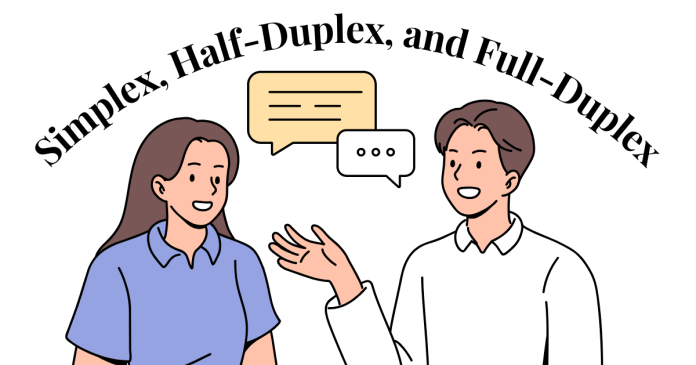Comparison Table
| Feature | Simplex | Half-Duplex | Full-Duplex |
|---|---|---|---|
| Direction of Data | One direction only | Both directions (one at a time) | Both directions simultaneously |
| Communication | Unidirectional | Bidirectional (alternating) | Bidirectional (simultaneous) |
| Speed | Fast (one-way only) | Slower (takes turns) | Fastest (simultaneous flow) |
| Example | TV Broadcast | Walkie-Talkie | Telephone Call |
| Cost | Lowest | Moderate | Highest |
In communication systems, data transmission modes determine how data flows between devices. Here’s a comparison of Simplex, Half-Duplex, and Full-Duplex modes:
1. Simplex
- Definition: Communication flows in one direction only.
- Example: Television broadcasting (signal travels from the broadcaster to the viewer).
- Features:
- Sender can only send data; receiver can only receive data.
- No feedback or acknowledgment from the receiver.
- Simple and low-cost communication.
2. Half-Duplex
- Definition: Communication flows in both directions, but only one direction at a time.
- Example: Walkie-talkies (only one person speaks at a time while the other listens).
- Features:
- Sender and receiver take turns to communicate.
- Requires control mechanisms to switch between sending and receiving modes.
- Slower than full-duplex but more efficient than simplex.
3. Full-Duplex
- Definition: Communication flows in both directions simultaneously.
- Example: Telephone calls (both people can speak and listen at the same time).
- Features:
- Continuous, two-way communication.
- Requires separate channels for sending and receiving data.
- Most efficient but requires more complex technology.
Conclusion
- Simplex: Best for one-way communication like TVs and radios.
- Half-Duplex: Suitable for systems requiring occasional two-way communication, such as two-way radios.
- Full-Duplex: Ideal for real-time two-way communication, like phone systems and modern internet connections.



